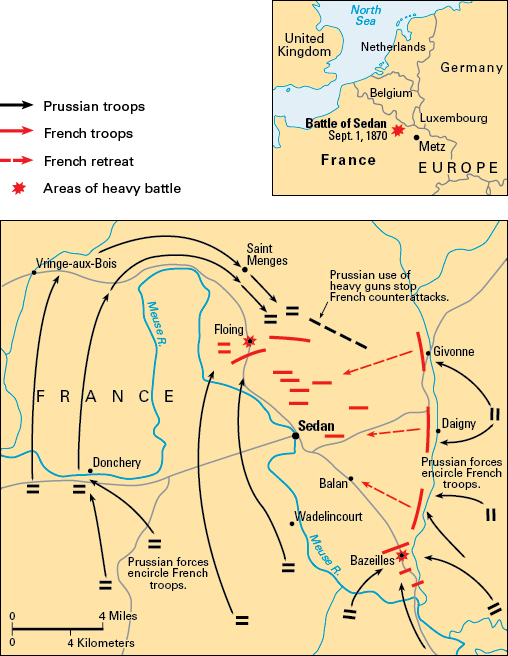Sedan << suh DAHN >> , Battle of, was fought between French and Prussian troops during the Franco-Prussian War (1870-1871). The battle took place around the northeastern French city of Sedan, on Sept. 1, 1870, and ended in a lopsided Prussian victory. The French defeat forced the surrender of Emperor Napoleon III along with over 100,000 French troops. The defeat also led to the collapse of France’s Second Empire and doomed French chances of winning the war. For Prussia, victory at Sedan helped strengthen its ties with other German states, leading to the creation of the German Empire in January 1871.
Background.
Prussia was a powerful Germanic nation in north-central Europe for hundreds of years. In the 1860’s, Prussia made military alliances with the south German states of Baden, Bavaria , Hesse , and Württemberg. Hoping to unite these states under a Prussian-led empire, Prussia provoked France into declaring war against Prussia in July 1870. The German states rallied around Prussia, and both France and Prussia entered the struggle with enthusiasm. General Helmuth Karl von Moltke , head of the Prussian Army, had made careful preparations for war with France. The French were largely unprepared.

The combined German forces defeated the French in a series of battles along the Franco-German frontier, inflicting severe losses. France’s two main armies under Marshals Patrice de MacMahon and Achille Bazaine were separated and kept apart by the Germans. Bazaine’s large army became surrounded at Metz . MacMahon, who had been ordered to march to the relief of Bazaine, met the Germans along the Meuse River on August 29. Small battles were fought at Nouart and Beaumont before MacMahon found his army—along with Napoleon III—nearly surrounded at Sedan.
German forces at Sedan eventually included some 250,000 troops and 700 heavy guns. The French army had about 120,000 troops and 500 guns. Artillery played a huge role in battles of that era. Heavy guns could turn the tide of a battle, and they caused horrific injuries.
The battle.
Early on the morning of September 1, heavy German guns began bombarding the French forces trapped in and near Sedan. German forces completed their encirclement and advanced on the city. Intense fighting took place, notably at the village of Bazeilles, just southeast of Sedan. To the north at Floing, Prussian guns and infantry stopped repeated French cavalry counterattacks. Other French attempts to break through the German defenses also failed as German guns continued to fire on the city. Napoleon III realized the situation was hopeless and arranged a truce that night. The next morning, the French—along with their emperor—surrendered, ending the battle.
Aftermath.
About 3,000 French soldiers were killed and about 14,000 were wounded in the Battle of Sedan. Some 21,000 were captured during the battle. On September 2, the rest of the French army—83,000 troops—also became prisoners of war. The Germans suffered about 9,000casualties (people killed wounded, captured, or missing) in the battle. News of France’s catastrophic defeat spread quickly to Paris , where a new French republic overthrew Napoleon III’s empire.
Later in September, the German army surrounded and lay siege to Paris, cutting off French supplies and communication. French attempts to break out failed, often with great loss of life. On October 27, Bazaine, his officers, and about 173,000 troops surrendered at Metz, but forces raised elsewhere in France continued fighting until January 1871. That same month, German guns began firing on Paris, and the city finally surrendered on January 28, 10 days after the creation of the German Empire.
